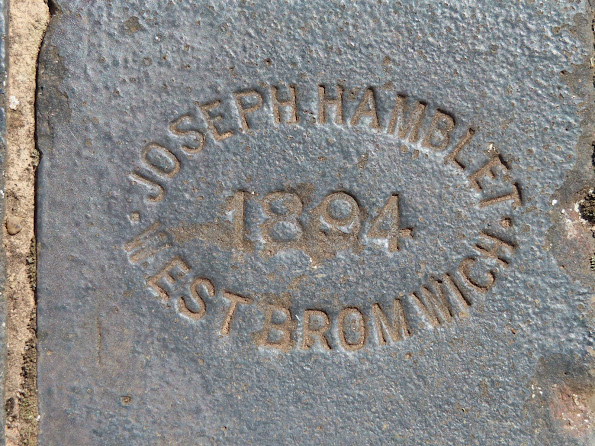We slept well last night and I don't know what time the pub went quiet as I was asleep straight away. A few boats passed us before, in both directions, we got away,
The weather was once again stupendous. It is getting a bit like being abroad at the moment, isn't it! We were soon at Stoke Top Lock
This blue brick was seen at one of the Stoke Locks, Wood and Ivery, Albion Works, West Bromwich. George Wood started his business in 1861 and went into partnership with Ivery in 1872 and by 1890 were producing 200,000 to 300,000 blue bricks a week. They continued in business together until 1904.
Tere is a lovely line of cottages with a blue coping stone capped wall around them, obviously canal workers cottages.
The tow path is largely overgrown. I understand the cutting policy to save money and to promote wildlife etc, and I think so long as you can get ashore there is still no reason for you not to moor in these areas. You can trample of cut a space for you to get off and on the boat. The Kennet and Avon seemed to be mostly like this and doesn't stop folk mooring as all the other places are taken.
This was the entrance to the Stoke Works Salt works. John Corbett was the son of a farmer who moved to Birmingham and set up a canal carrying business. John set about leading the boat horse but eventually became a boat captain. We really wanted to be an engineer, and realised that the company's main cargo was salt. He did his book learning and got taken on for a 5 year apprenticeship at a Stourbridge ironworks. He then went to work at the Stoke Prior Salt Works. He started as an engine driver, outrider and a cashier, learning the business at all levels. In 1852 the company went bust. John managed to convince the bank to allow him to get the lease in 1852. At that time the production was 26,000 tons a year. John put all his practical skills into practice and by 1876 it was up to 200,000 tons and in 1886 it was 300,000 tons a year. This was not the end of the story, but this was the entrance to the works and alongside the canal were many moorings too.
I intended to see if I could find anything out about this little cottage that was looking lovely in the sun, but no time today unfortunately, so you will have to make do with the picture.
This brick was found on one of the Atwood Locks. Joseph Hamblet was trading from the Oak Road, West Browich from around 1851 when he acquired the J.E Piercy's estate. He ran the brick works with a Mr. Parkes into the 1860's before the partnership was dissolved and Hamblet ran it by himself. In the 1880's and 90's they were making every kind of brick but specialised in the blue bricks. 1894 was the year that J. Hamblet died. In 1898 the company became a limited company and became the Hamblet Blue Brick Co. The company was still working in Walsall in 1961!
At the bottom of the Astwood Flight you get a view of the Transmitter masts at Droitwich Transmitters. It was set up in 1934 and you could always find it on the old fashioned tuner dial. In WWII it transmitted those cryptic/coded messages to the French Resistance, and also announce the start of the D Day landings to the Resistance. Now a days it is the main long wave transmitter for the BBC and transmits Radio 4 LW. It also transmits Radio 5 Live MW to the East Midlands and Wales.
We trundled on until we got to Hanbury Junction. There seemed to be several boats alongside with ropes being held as though they were waiting to go down the Droitwich canal, but they were just all getting ready to leave at the same time. We turned down the Droitwich Arm.
The volunteer lock keepers scattered from below their gazebo to usher us down the locks. These have side pounds and the bloke is working us down saving some water as we go. We had a slight delay as there was a boat coming up.
down the three locks, past the marina and up to the Rugby Club Bridge. The angle of the bridge abutments has meant that for the bridge, and boats, require these serious fenders to prevent damage to both.
There is a staircase lock and another single lock before we get ready to duck under the M5 Motorway. Other than leveling out the solar panels we fitted with a few centimeters clearance.
Not the best photo but it is pleasing to me to see that embossing bricks is not dead. Although the date is 2008, which was when the lock was rebuilt, the canal was opened between the Worcester and Birmingham Canal and the River Severn in 2011.
The canal now pens down into the river Salwarpe for the rest of the trip to Droitwich. There is then a lock at the start of Vines Park and then a series of swing bridges, 3 of which have to be unlocked and opened, before arriving at Netherwich Basin where we moored for the night.














No comments:
Post a Comment